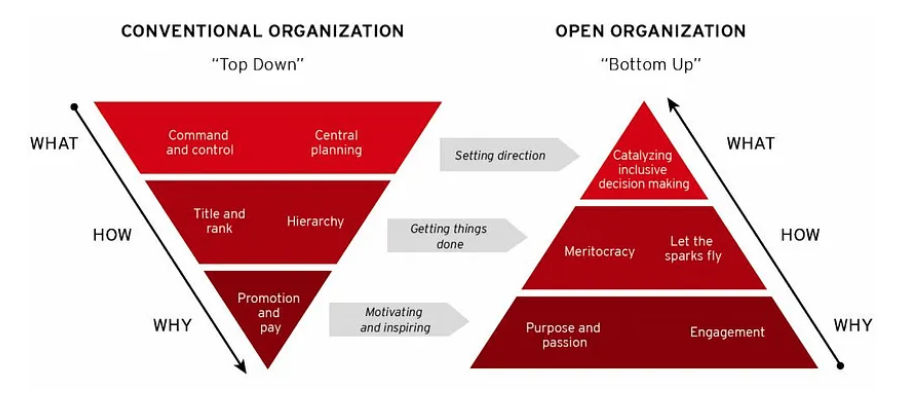April 16, 2024
Background:
The story of schools is the story of evolving control and growth patterns in learning institutions. The currently dominant model of education [siloed, top down, student compliance focused] began centuries ago, was later refined by a Prussian military leader who wanted to use the factory model to make industrial workers in the 19th century and has been coming under pressure with the rise of digital technology, modern work norms, and the needs of the rising generation of learners.
Concurrent with the industrial model for education there have also been ongoing experiments in other ways of organizing learning. Benjamin Hunter Miller has given us a neat way to summarize the two approaches and their related cultures and values.
This article will offer a summary of the two approaches and why the triangle on the right below is going to gain more and more traction in coming years as the current model, summarized in the left below, struggles to contend with the forces of change, labor market reality and the way actual cognitive building blocks are assembled in the minds, hearts and bodies of the learners working their way through schools now. Both modes are necessary in any school — matching your mix to your environment is how you will chart a journey to ongoing success and financial viability.

Conventional Organizations decide their ‘what’—their direction and strategy—in a command-and-control way, relying on central planning. They get things done by relying on titles and hierarchy to organize activity. Prestige is the coin of the realm. They motivate their employees with promotion, pay, and, in most schools, seniority perks.
By contrast Open Organizations start from the premise of being adaptive and responsive, unlocking human potential and motivation to fuel their organization. Open Organizations work by bringing opportunities to many people and experimentation. They set organizational course inclusively, bringing to the table all stakeholders to sense and adapt to the needs, threats and opportunities they identify. The coin of the realm is purpose, not prestige. Almost any innovation ever has come up on the pyramid on the right. If your school talks about innovation, promises innovation, or practices it, you will recognize the language of innovation on the right pyramid.
Current state:
Of course in reality there is always a mix of the two modes above present in any organization. To just be Bottom Up in a school context would be too upsetting to too many stakeholders. To be just Top Down would be suicidal in the current educational and professional environment. The question for school leaders is what is the right mix of top down and bottom up for the current operating environment.
As independent schools work their way towards financial sustainability, or not, they face an open market of buyers for whatever sort of education they offer. Being ‘fit for purpose’ requires a school to serve an end user/learner on their terms or the terms of their proxy [i.e. parent] for what their future looks like —what threats and opportunities are present — and what they feel makes progress for them.
Because almost all leaders in schools now were steeped in top down as their professional journey unspooled, few schools have too little of that mode. Because most school leaders did not see functional models of bottom up organization outside of a single team, department or teacher, they do not have a reference model to begin to improve their bottom up culture and practice. School leaders who, as teachers, were traditional in their pedagogy often struggle to even believe a real bottom up organization is even possible! Nevertheless, schools have to pay their bills and if that isn’t going so well now, if you rely more and more on fundraising and non-tuition activities to balance your budget, then looking for more top down leadership to create the innovations your school needs likely won’t go well. So what is the school leader to do if they want to bring more bottom up ways of working into their school and maintain clear lines of accountability and action?
Improve your top down/bottom up mix, given your local context and market. Here are a couple of suggestions for how to start.
- Consider doing a design challenge with your a) Admin Team or b) Trustees or c) Faculty to target one discrete opportunity to create one change to a current process or structure to allow more bottom up initiative.
- Allow your a) Admin Team or b) Trustees or c) Faculty to open up new lines of communication with parents by engaging in “continuous discovery” of their needs, pain points and blind spots.
- Set aside time with your a) Admin Team or b) Trustees or c) Faculty to play Innovation Games and discover new ideas for how to move your school towards more bottom up or top down ways of working.
- Bring in experts who can help you assess your situation and start to make small incremental changes built explicitly around bottom up ways of working.
The best part, as a leader, of bringing in bottom up ways of working is seeing how much energy is unlocked and how many ideas and solutions can bubble up in a short amount of time for little cost. Bottom up working allows people to stretch and grow, either in the classroom or the Admissions Office or Business Office or the Dean’s Office.
As a leader you stop sending the message that you are the source of all action and initiative and you start sending the message that the challenges you face will be tackled as a community, as a team, as a faculty, as people newly in contact with what got you into education in the first place. And when you start to see that self-organization happening, you can raise a toast to change: bottoms up!
You may also be interested in reading more articles written by Simon Holzapfel for Intrepid Ed News.


